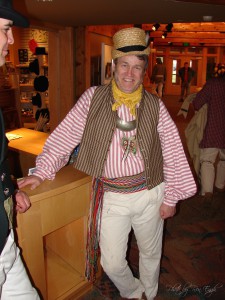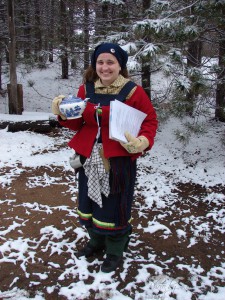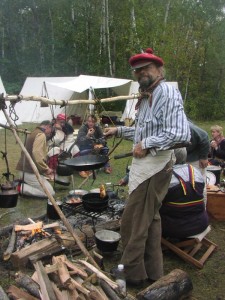
Color, pattern, honest stains and patches and a little silver as befits the status of guide.
Okay, you bought, borrowed or made enough clothes to get you to events. Nothing fine, nothing flashy, nothing unusual. You felt almost comfortable and learned to handle the inevitable question, “Why are you wearing those funny clothes?”
Now what? What can you do to improve your fur trade impression?
Since one of our goals as historical interpreters is to convince others that we know what we are talking about, our appearance, especially our clothing, can be as important as our words in creating that impression.
So now that you have the basics, you might think about getting away from that generic “voyageur from central casting” look. As time, budget and skills allow, consider making some of these simple changes to improve your personal authenticity . . .
- Clash artfully. Plain fabrics are safe, but woven-in checks, symmetrical stripes and floral prints add fun. Avoid matching or head-to-toe color coordinated looks. Don’t be afraid of color or pattern. Do your research to find a colorful fabric that makes you smile. Then search out quality reproduction fabric and use it for something like a handkerchief, shirt or short gown.

Lots of color, some pattern, a little bling . . . a good “look” for a woman of the fur trade.
- Decorate. A small amount of silver jewelry or a few strings of beads are a good way to illustrate the various categories of trade goods. Useful technology versus personal adornment. Practicality and durability versus bling! Search out the very best of the artisans and vendors and take their advice. Don’t skimp. Expect to pay a pretty penny for the most accurate stuff.
- Get dirty. Stifle the urge to wash your clothes after every wearing. During an event, do change/wash your undergarments as often as necessary, but let outer ones acquire period appropriate stains and wear. Skip the dryer and the softener products; crisp line-dried laundry has “the look” you’re after.
- Smell bad. Skip perfumes, make up and heavily scented hair products. Besides attracting insects such as gnats, scents can be irritating to others and exude a modernity that will undo your best efforts at a “hearty voyageur” impression.
- Mix it up. Women, use your clothes to demonstrate the clash of cultural influences during the fur trade. Wear clothing that gives a more mixed impression. Save your petticoats for dances and fancy dress events. Wear a wrap skirt and short gown instead. Switch out shoes and stockings for moccasins and leggings. And that lace-up bodice thing? Save it for the Ren Fest!
- Fuss over details. Get yourself a silk handkerchief. Replace the polyester ribbons on your finery with silk. Disguise machine-made buttonholes with hand stitching. Swap out plastic or antler shirt buttons for simple shell or bone. Hand sew your hems.
- Use more linen. Cotton was not all that common, especially among the lower classes. Linen was the choice. Because it wears like iron and keeps you cool in steamy weather, you’ll get more wear and comfort from your investment. Besides, it fades and looks worn quicker!
- Bag it. Leather bags, canvas bags, waxed bags, drawstring bags, “ditty” bags, beaded bags. Bags with quillwork. Lunch bags. Shooting bags. Make yourself a bunch and you’ll always have a place to stash, hold, carry or conceal.
- Learn to love wool. Get yourself a wool blanket, short jacket, apron or petticoat. Wool clothing was common for men and women of all classes and can be worn year round if it’s light enough. Dark, solid colors are good choices. On a damp, wet day in camp, there is nothing better. Plus, you‘ll be safer around the fire.
- Get some tools. Learn how to use, clean and sharpen them. A fire starting kit, sewing kit, small tomahawk or knife are all handy to have in camp. Show how a tump line is tied around bales and how it makes carrying heavy loads easier. And sometime, simply sorting and rearranging our collection of metal trade goods can be a whole demonstration in itself!
- Do something. Chop wood. Collect kindling. Make char cloth, coffee, tea, bannock. Whittle. Mend. Learn to finger weave. Clean the musket. Polish the silver. Wash dishes. Ask youngsters to help with easier tasks. One of us once entertained a crowd of youngsters simply by cutting up vegetables to make soup! (PS: Leave the knitting and crocheting at home.)
- Learn to squint. If you can’t wear contact lenses, invest in a suitable pair of antique or reproduction eyeglasses. Better yet (and cheaper!), learn to go without. Squinting and holding items close to your eyes are historically accurate behaviors!
caption id=”attachment_773″ align=”alignleft” width=”225″] Colorful, sturdy, practical gear . . . just what every voyageur re-enactor should have![/caption]
Colorful, sturdy, practical gear . . . just what every voyageur re-enactor should have![/caption]
So there you have it . . . a dozen ideas of how to personalize your fur trade clothing and improve your personal authenticity at the same time. Don’t worry about being perfect . . . just get dressed and get out there. As long as you don’t show up looking like Ma Ingalls or Grizzly Adams, we’re happy to have you along!
One last piece of advice: Don’t forget to wear a hat and unscented sunblock. Sunburn and skin cancer should not be part of your impression!
Huge thanks to members LisaK and LindaB for their many thoughtful suggestions to this article way back when it was supposed to be a Journal article!

